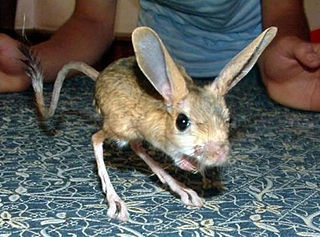
Jerboas are the members of the family Dipodidae. They are hopping desert rodents found throughout North Africa and Asia. They tend to live in hot deserts.

The four-toed jerboa is a rodent of the family Dipodidae and genus Scarturus that has four digits. Four-toed jerboas are native to Egypt and Libya. They live in coastal salt marshes and dry deserts.

Dipodoidea is a superfamily of rodents, also known as dipodoids, found across the Northern Hemisphere. This superfamily includes over 50 species among the 16 genera in 3 families. They include the jerboas, jumping mice, and birch mice. Different species are found in grassland, deserts, and forests. They are all capable of saltation, a feature that is most highly evolved in the desert-dwelling jerboas.

The genus Jaculus is a member of the Dipodinae subfamily of dipodoid rodents (jerboas). Jaculus species are distributed in desert and semi-arid regions across northern Africa, the Sahara, the Horn of Africa, Arabia, the Middle East, and Central Asia.

Dipus is a genus of jerboa. Today only a single species is usually recognized, the northern three-toed jerboa (Dipus sagitta), widespread throughout Central Asia. Some authors recognize a second species, the Qaidam three-toed jerboa from the Qaidam Basin of western China. The genus has a fossil record that dates back to the Miocene, with several extinct species known from Asia. The oldest dated species is Dipus conditor.

Stylodipus is a genus of rodent in the family Dipodidae. It contains the following species:
This page is based on this
Wikipedia article Text is available under the
CC BY-SA 4.0 license; additional terms may apply.
Images, videos and audio are available under their respective licenses.



